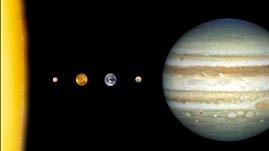Teachers' Domain - Digital Media for the Classroom and Professional Development
User: Preview

Source: Lunar and Planetary Laboratory
In our solar system, there are at least eight planets orbiting the Sun. Because of the way in which the solar system formed, each planet developed particular characteristics based on its distance from the Sun. In general, small rocky planets are located close to the Sun and large gaseous planets are further away. This image from the Lunar and Planetary Laboratory illustrates the approximate relative sizes of the Sun and planets and their relative location (although distance is not to scale).
The eight major planets orbiting the Sun can be grouped into two categories. The four inner planets—Mercury, Venus, Earth, and Mars—are terrestrial planets. They are relatively small, with rocky surfaces and metal cores. The four outer planets—Jupiter, Saturn, Uranus, and Neptune—are called Jovian planets. They are relatively large and cold, and have a gaseous composition.
All eight planets travel around the Sun in nearly circular orbits, in the same plane, and in the same direction. This orderliness to their movements, as well as their physical traits, can be explained by the nebular theory of solar system formation. According to this theory, a cloud of interstellar gas—composed roughly of 98% hydrogen and helium and 2% other elements—collapsed under its own gravity, causing the matter to spin faster and flatten into a rotating disk. As the temperature cooled, the matter in the disk condensed into clumps of particles that would grow into planets.
Because of the difference in temperature in the inner and outer parts of the disk, two different types of planets were formed. Closer to the center of the disk where the Sun was forming, rocks and metals condensed to create the terrestrial planets. Farther away from the Sun, where it was cold enough for the abundant levels of hydrogen to form ice, the outer planets grew much larger than those made of metals and rocks. In addition, the larger mass and gravity of the growing Jovian planets allowed them to capture the abundant hydrogen and helium gases, turning them into gaseous giants.
Pluto, sometimes called the ninth planet, is an oddball—a tiny, solid, icy world with a very elliptical and distant orbit. These characteristics have led scientists to believe that Pluto is actually a member of the Kuiper belt—a collection of comets that orbit the Sun beyond Neptune. In July 2005, a new large Kuiper belt object was discovered. It is larger than Pluto and has an orbit about three times as distant. If Pluto is considered a planet, then this new object is a tenth planet.
The scale of the solar system is so large that it is very difficult to accurately represent both the size of the planets and the distance between them. This image shows the approximate sizes of the planets relative to each other, and displays them in the order of their distance from the Sun. However, on an accurate scale model, if the Sun were about the size of an 8-inch ball, Earth would be about the size of a peppercorn located about 26 yards away from the ball and Pluto would be smaller than a pinhead located about half a mile away.
 Loading Standards
Loading Standards Teachers' Domain is proud to be a Pathways portal to the National Science Digital Library.
Teachers' Domain is proud to be a Pathways portal to the National Science Digital Library.
